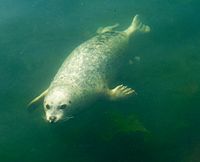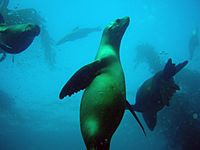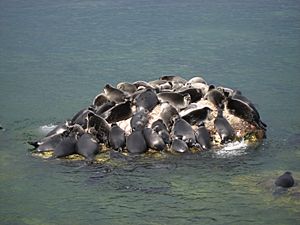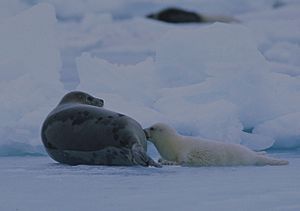Pinniped facts for kids
Quick facts for kids Pinnipeds |
|
|---|---|
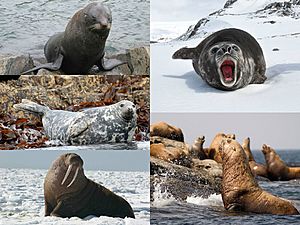 |
|
| Clockwise from top left: New Zealand fur seal (Arctocephalus forsteri), southern elephant seal (Mirounga leonina), Steller sea lion (Eumetopias jubatus), walrus (Odobenus rosmarus) and grey seal (Halichoerus grypus) | |
| Scientific classification | |
| Subclades | |
|
|
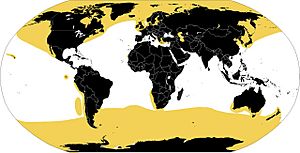 |
|
| Range map |
Pinnipeds are the seals and their relatives, a group of semi-aquatic marine mammals. The Pinnipedia is in the Order Carnivora. There are three seal families: Odobenidae (walruses), Otariidae (eared seals, including sea lions and fur seals), and Phocidae (true seals).
Seals are sleek-bodied and barrel-shaped. Their bodies are well adapted to the aquatic habitat where they spend most of their lives. Pinnipeds have flippers for hands, big bulky bodies, doggish faces, and big eyes. Unlike cetaceans, pinnipeds have their noses on their face, and each nostril of the nose closes when the pinniped goes under water. Like cetaceans, pinnipeds have a thick layer of blubber (fat) just under their skin: this blubber keeps them warm in cold waters and keeps them fed during times when food is not easily found. When they cannot find food, they live off the fat in the blubber. Pinnipeds are carnivorous. This means they eat only meat (such as fish or squid) and not plants. However, almost all pinnipeds can be eaten by sharks or orca whales.
Pinnipeds are carnivorous. This means they eat only meat (such as fish or squid) and not plants. However, almost all pinnipeds can be eaten by sharks or orca whales.
Seals are often trained in zoos or aquariums to put on shows. However, in Sweden, it is illegal to train a seal to balance a ball on its nose.
Contents
Sleep
Pinnipedes sleep in the water. They may also sleep on land. In both environments, there is danger. At least in the northern hemisphere, there is danger from polar bears on land; and in the water there is danger from sharks. While sleeping in water, the animals go through different stages of sleep. They do some behaviours during sleep: they come to the surface occasionally to breathe, and they now and then open an eye for a period of time. The details vary in different species or group. Similar adaptations are found in cetaceans like dolphins.
Anatomy and physiology
Pinnipeds have streamlined bodies with reduced or non-existent external ear flaps, small tails and limbs modified into flippers. Pinnipeds range in size from the 1 m (3 ft 3 in) and 45 kg (99 lb) Baikal seal to the 5 m (16 ft) and 3,200 kg (7,100 lb) southern elephant seal. Overall, they tend to be larger than other carnivorans. Several species have male-biased sexual dimorphism that correlates with the degree of polygyny in a species. Highly polygynous species like elephant seals are extremely sexually dimorphic, while less polygynous species have males and females that are closer in size. In lobodontine seals, females are slightly larger than males. Pinnipeds are unique among carnivorans in that their orbital walls are significantly shaped by the maxilla and are not limited by certain facial bones.
The majority of pinnipeds have fur coats, the exception being the walrus, which is only sparsely covered. However, even some fully furred pinnipeds (particularity sea lions) are more sparsely haired than most land mammals. In species that live on ice, young pups have thicker coats than adults, known as lanugo. The individual hairs on the coat are able to trap heat from sunlight and keep the pup warm. Pinnipeds typically have countershaded pelage colors, being darker colored dorsally and lighter colored ventrally. This serves to eliminate shadows caused by light shining over the ocean water. The pure white fur of harp seal pups conceals them in their Arctic environment. Some species like ribbon seals, ringed seals and leopard seals have patterns of contrasting light and dark coloration. All pinnipeds molt; earless seals molt once a year while eared seals gradually molt all year.
Pinnipeds have a layer of subcutaneous fat known as blubber that is particularly thick in earless seals and walruses. Blubber serves both to keep the animals warm and to provide energy and nourishment when they are fasting. Blubber can make up as much as 50 percent of a pinniped's body weight and the blubber layers of walruses and elephant seals can be as thick as several inches. Pups are born with a thin layer of blubber and some species make up for this with their thick lanugos.
Locomotion
Unlike other marine mammals, pinnipeds have two pairs of flippers on both the front and back, the fore-flippers and hind-flippers. The elbows and ankles are enclosed within the body. Pinnipeds tend to be slower swimmers than cetaceans, typically cruising at 5–15 kn (9.3–27.8 km/h; 5.8–17.3 mph) compared to around 20 kn (37 km/h; 23 mph) for several species of dolphin. However, pinnipeds have better agility and flexibility. Eared seals, like the California sea lion, are capable of bending their necks backwards far enough to reach their hind-flippers and can make dorsal turns. Pinnipeds have several adaptions for reducing drag. In addition to their streamlined bodies, they have smooth networks of muscle bundles in their skin that may increase laminar flow and make it easier for them to slip through water. They also lack arrector pili so their fur can lay flat as they swim.
When swimming, eared seals rely on their fore-flippers for locomotion in a manner similar to penguins and sea turtles. Fore-flipper movement is not continuous and the animal glides between each stroke. Compared to territorial carnivorans, the fore-limbs of eared seal are reduced in length. This gives the locomotor muscles at the shoulder and elbow joints greater mechanical advantage. The hind-flippers of eared seal serve as stabilizers. Earless seals and walruses swim by moving their hind-flippers and lower body from side to side. Their fore-flippers are mainly used for steering. California sea lions and harbor seals occasionally leap out of the water. This may allow then to travel faster. In addition, sea lions are known to "ride" waves, which probably helps them decrease their energy usage.
Pinnipeds can move around on land, though not as well as terrestrial animals. Eared seals and walruses are capable of turning their hind-flippers forward and under the body so they can "walk" on all fours. The fore-flippers move in a transverse, rather than a sagittal fashion. Eared seals rely on the movements of their heads and necks more their its hind-flippers during terrestrial locomotion. By swinging their heads and necks, eared seals create momentum while they are moving. Sea lions have been recording climbing up flights of stairs. Earless seals are less agile on land. They can not pull their hind-flippers forward and move on land by lunging, bouncing and wiggling while their fore-flippers keep them balanced. Some species use their fore-flippers to pull themselves forward. Terrestrial locomotion is easier for earless seals on ice as they can sled along.
Senses

The eyes of pinnipeds are relatively large for their size and are positioned near the front of the head. One exception is the walrus, whose smaller eyes are located on the sides of its head. This is because it feeds on immobile bottom dwelling mollusks and hence does not need acute vision. A pinniped's eye is adapted for seeing both underwater and in air. The lens is mostly spherical and much of the retina is at equal distance from the lens center. The cornea has a flattened center where refraction is nearly equal in both water and air. Pinnipeds also have very muscular and vascularized irises. The well-developed dilator muscle gives the animals a great range in pupil dilation. When contracted, the pupil of a pinniped is typically pear-shaped although the bearded seal's is more diagonal. In species like harbor seals and California sea lions, which live in shallow water, dilation varies little while the deep- diving elephant seals have much greater variation.
On land, pinnipeds are near-sighted in dim light. This is reduced in bright light as the retracted pupil reduces the lens and cornea's ability to bend light. Pinnipeds also have a well-developed tapetum lucidum that sends light passing though the retina a second time, which doubles the light-gathering of the rods. This helps them see in darkness. Ice-living seals like the harp seal have corneas that can tolerate high levels of ultraviolet radiation typical of bright, snowy environments. As such, they do not suffer snow blindness. Pinnipeds appear to have limited color vision as they lack S-cones. Flexible eye movement has been documented in pinnipeds. The extraocular muscles of the walrus are well developed. This and its lack of orbital roof allow it to protrude its eyes and see in both a frontal and dorsal direction. However, vision in this species appears to be more suited for short-range. Pinnipeds release large amounts of mucus to protect their eyes.
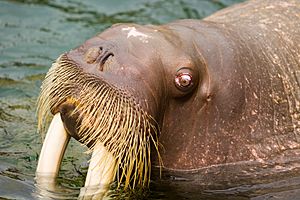
The pinniped ear is well adapted for hearing underwater, where they can hear sound frequencies at up to 70,000 hz. In air, hearing is somewhat reduced in pinnipeds than in many terrestrial mammals. While they are capable of hearing as many sound frequencies as humans their hearing sensitivity is overall weaker. One study of three pinniped species, the harbor seal, California sea lion and northern elephant, found that the sea lion was best adapted for airborne hearing, the harbor seal was equally capable of hearing in air and water, and the elephant seal was better adapted for underwater hearing. Pinnipeds have a fairly good sense of smell on land. However, it is useless underwater as their nostrils are closed.
Pinnipeds have well-developed tacile senses. Their vibrissae have ten times the innervation of terrestrial mammals, allowing them to effectively detect vibrations in the water. This is useful when the animals are foraging and may add to or replace vision, particularly in darkness. Walruses have the most vibrissae, at 600–700 individual hairs. These are important for detecting their prey on the muddy sea floor. Unlike terrestrial mammals such as rodents, pinnipeds do not move their when examining an object but extend their moveable whiskers and keep them in the same position. In addition to foraging, vibrissae may also play a role in navigation. Spotted seals appear to use them to detect ice holes.
Distribution and habitat
Living pinnipeds mainly inhabit polar and subpolar regions, particularly the North Atlantic, the North Pacific and the Southern Ocean. Monk seals and some eared seals live in tropical and subtropical waters. Pinnipeds usually require cool, nutrient rich waters with temperatures lower than 20 °C (68 °F). Even those that live in warm or tropical cilmates typically inhabit areas that are cold and rich in nutrients due to current patterns. Only the monk seals live in waters that are not typically cool or rich in nutrients. Two species, the Caspian seal and Baikal seal are found in large landlocked bodies of water (the Caspian Sea and Lake Baikal respectively).
As a whole, pinnipeds can be found in a variety of aquatic habitats including coastal water, open ocean, brackish water and even freshwater lakes and rivers. Most pinnipeds inhabit coastal areas though some species travel offshore and feed in deep waters off oceanic islands. Elephant seals are known to dive up the 1,754 m (5,755 ft). The Baikal seal is the only freshwater species of pinniped. However, two subspecies of ringed seals are known to live in landlocked lakes in Russia close to the Baltic sea. In addition, harbor seals are known to visit estruaries, lakes and rivers and sometimes stay as long as a year. Other species known to enter freshwater include California and South American sea lions.
Pinnipeds also use a number of terrestrial habitats and substrates, both continental and island. In temperate and tropical areas, they haul-out on sandy and pebble beaches, rocky shores, shoals mud flats, sea caves and tidepools. Some species also exploit man-made structures like piers, jettis, bouys and oil platforms. Pinnipeds may move further inland and rest in sand dunes or vegetation and even climb steep cliffs. Polar-living species utilize either fast ice or pack ice.
Life history
Reproduction
Males of some species, including elephant seals, South American sea lions, and northern fur seals, aggressively defend groups of specific females, referred to as harems. Males of other species, including most sea lions and brown fur seals, defend territories on reproductive rookeries while females move freely between them. Occasionally, violent competition for females or territories is an integral part of male breeding strategy among most pinnipeds. Otariids, which are generally more land-adapted, form major aggregations in the summer months on beaches or rocky outcrops. Consequently, their reproductive behavior is easier to observe and relatively well-studied. Walruses reproductive behavior and many phocids is less well known.
After giving birth, mothers suckle their young for a variable period.
After the female returns from her first feeding trip, the most important task for her is to find her own pup out of the mass of other pups. Feeding a different mother's pup is a significant waste of energy, as milk production has a high parental cost. The seal overcomes this complication by voice recognition. The mother and pup must learn each other's voices in the first few days after the pup is born, before the dam goes on her next hunt. On returning, the mother seal calls out to her pup, causing the pup to call back. This enables the mother to find her own pup and not waste any energy feeding and taking care of the wrong pup, as this would only decrease her own fitness.
Diving
Some pinnipeds can hold their breath for nearly two hours underwater by conserving oxygen. During long duration dives, the heart rate can be reduced to about one-tenth of its normal rate. The arteries vasoconstrict and the sense organs and nervous system are the only organs to receive normal blood flow. They are able to resist more pain and fatigue caused by lactic acid accumulation than other mammals. However, once they return to the surface, they need time to recover and normalize their body chemistry.
Sleep
Pinnipeds spend many months at a time at sea and so they must sleep in the water. Scientists have recorded them sleeping for minutes at a time while slowing drifting downward belly up.
Like other marine mammals, pinnipeds sleep with half of their brain awake so that they are to be able to detect and escape from predators. When pinnipeds are asleep on land, both sides of their brain go into sleep mode.
Ecology
Diet
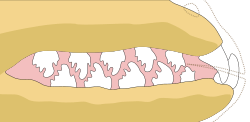
Pinnipeds are carnivorous, eating fish, shellfish, squid, penguins, and other marine creatures. Most are generalist feeders, but some specialize. For example, Ross seals and southern elephant seals mainly feed on squid. Crabeater seals eat mostly krill, and ringed seals almost exclusively consume crustaceans. The walrus consumes its molluscan prey by sucking the soft parts from the shell.
Some seals eat warm-blooded prey, including other seals. The leopard seal, which is probably the most carnivorous and predatory pinniped, eats penguins as well as crabeater and Ross seals. The South American sea lion also eats penguins, flying seabirds and young South American fur seals. Steller sea lions eat northern fur seal pups, common seal pups, and birds.
Predation
Almost all pinnipeds are potential prey for orcas and larger sharks. Arctic species are an important component of polar bear diets. Antarctic seals, however, are not preyed upon by terrestrial predators, unlike seals in the Arctic.
Survival
As the Arctic ice pack diminishes, more species of pinnipeds are hauling out on the shores. Walrus and spotted seals on the coasts of the United States, Canada, and Russia, show increasing signs of an often-fatal, mystery disease of unknown etiology. Harp seals in Greenland may be similarly affected.
The Caribbean monk seal was declared extinct in 2008.
Images for kids
-
Male and female South American sea lions, showing sexual dimorphism
-
Frontal view of brown fur seal head
-
Walrus on ice off Alaska. This species has a discontinuous distribution around the Arctic Circle.
-
Leopard seal capturing emperor penguin
-
Inuit seal sculptures at the Linden Museum
See also
 In Spanish: Pinnipedia para niños
In Spanish: Pinnipedia para niños



